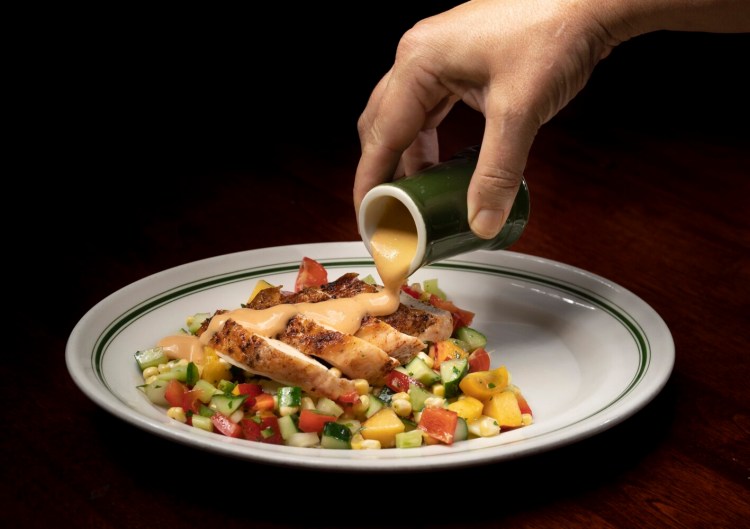In the dog days of late August, whenever I see high school athletes enduring torturous double-session practices leading up to fall sports seasons, my mothering mind fixates on hydration. During the years when my own soccer goalie and field hockey midfielder played for Brunswick, I routinely feared they would suffer the consequences of not putting back into their bodies the amount of water they were sweating out during these sessions.
Yes, my kids’ water bottles were filled, refilled, and sometimes even frozen so that the water would thaw as they practiced but be cold when they needed it to be. And their water intake was sometimes supplemented with more flavorful electrolyte-filled fluids like Gatorade (my son’s preference) and pickle juice (my daughter’s). But I also put water-heavy foods on the table. After all, while a healthy body typically gets 80% of its daily water intake from beverages, the remaining 20% usually comes from food.

Celery has a high water content, making it a good choice for summertime eating. Gregory Rec/Staff Photographer
Cucumbers and lettuce are 95 percent water. Zucchini weighs in at 90 percent. Watermelon is 92 percent water while apples, blueberries and peaches are 85 percent. One cup of sliced, raw tomatoes contains 5.7 ounces of water. One cup of chopped celery has almost four. The high amount of water in watercress is one of the reasons it topped the list of powerhouse fruits and vegetables compiled by the Centers for Disease Control and Prevention.
No, this is not a nutrition column. It is a green eating one. So here is where I get to the point. Local fruits and vegetables are the best hydrators. Here’s why: As soon as they’re harvested, fruits and vegetables begin to lose moisture through the process of transpiration. Because the fruits and vegetables contain more water than the air, the water gets pulled from them into the atmosphere. While refrigeration engineers have built their careers on minimizing how much transpiration happens when California-grown vegetables are trucked across the country to Maine, the fact is, that number will never be zero. Buying uber-fresh fruits and vegetables locally, then, is your best bet if you’re looking to them for hydration.
How you prepare water-heavy food also affects their hydration worth. Raw is always best. Chopped, sliced, shaved and whole all keep the water in the vegetables cells.
But if you must cook water-heavy vegetables, steaming them with their skins still on helps retain the most water, not to mention the most water-soluble nutrients like folate, thiamine, riboflavin, niacin, pantothenic acid, biotin, vitamins B6, B12 and C. Potatoes lose well over half of their water when baked. Boiling them is a better bet.
If you want to build a hydrating meal, consider carbohydrates that absorb water as they cook. Thinks steel-cut oats for breakfast and legumes, rice, pasta and whole grains at other meals.
Animal proteins are also a good source for hydration as they contain between 65 and 75 percent water before cooking. Because the water-holding capacity is a function of the protein molecules (as opposed to the fat ones), leaner cuts of beef, chicken and pork hold more water than fattier ones do.
In general, the higher the cooking temperature, the more moisture meat will lose during cooking. A beef roast may lose one-third of its original size and weight when cooked at a high temperature. So lower (heat) and slower (cooking time) will help the meat retain moisture. For chicken and fish, intact skin also helps. Whichever protein you chose, let it rest for 10 minutes before slicing to help keep the juices in the cells. Finally, pouring the pan juices over said sliced meat before serving it is also an excellent idea.
Waste not, want not applies when talking about water content in the kitchen.

This hydrating salad combines fresh corn, cucumbers, celery, red peppers, cherry tomatoes and nectarines, and is topped with grilled chicken. Gregory Rec/Staff Photographer
Thirst-Quenching Chopped Vegetable and Grilled Chicken Salad with Chipotle-Lime Dressing
Since this recipe calls for both fresh corn kernels and bit of broth to thin out the dressing, I simmer the spent cobs in water with onion peels, a garlic clove, a bay leaf, and a few sprigs of thyme to make corn stock.
Serves 4
FOR THE DRESSING:
1 cup plain Greek yogurt
1 chipotle pepper in adobo
Zest and juice of 1 lime
1 tablespoon honey
1 teaspoon minced garlic
1 teaspoon kosher salt, or more to taste
Vegetable broth
FOR THE SALAD:
2 (8-ounce) skin-on chicken breasts, grilled
4 cups fresh corn kernels (from about 4 ears)
4 pickling cucumbers, chopped
2 red bell peppers, cored chopped
2 cups chopped celery
1 pint cherry tomatoes, halved
2 peaches, pits removed and chopped
1/4 cup chopped parsley
1 jalapeño pepper, chopped
Zest and juice of 1 lime
1 tablespoon olive oil
1 teaspoon salt
To make the dressing, combine the yogurt, chipotle pepper, lime zest and juice, honey, garlic and salt in a blender canister. Cover and puree. Add the broth to thin it out to the consistency you prefer. Store in the fridge until you are ready to serve the salad.
To make the salad, first slice the chicken thinly on the bias. Set aside.
In a large bowl, combine corn kernels, cucumbers, bell peppers, celery, cherry tomatoes, peaches, parsley, jalapeño pepper, lime zest and juice, olive oil and salt.
Spread the salad out on a large platter. Fan the chicken on top of it. Drizzle some dressing over the chicken and serve.
Send questions/comments to the editors.


